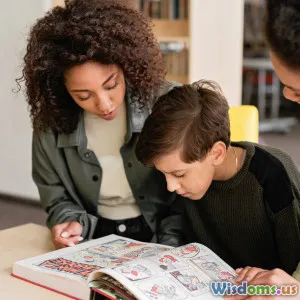
Creating Inclusive Learning Environments
8 min read Explore how to build inclusive learning environments that foster equity, engagement, and student success. (0 Reviews)
Creating Inclusive Learning Environments: A Pathway to Equity and Engagement
Imagine a classroom where every student feels seen, valued, and equipped to succeed—regardless of their background, abilities, or learning styles. Creating such an inclusive learning environment is not merely an aspiration but an educational imperative in today's diverse world. It fosters equity, bridges achievement gaps, and promotes holistic development enabling learners from all walks of life to thrive.
Why Inclusive Learning Environments Matter
Education is the cornerstone of social equity and democratic participation. According to UNESCO, inclusive education is fundamentally about respecting and embracing diversity, reducing barriers, and emphasizing personalized supports. Yet, nearly 15% of the world’s population lives with disabilities, and many culturally diverse students face systemic challenges in conventional educational settings. Inclusive environments reduce dropout rates, improve academic outcomes, and support social cohesion.
A landmark analysis by the National Center for Education Statistics (NCES) found that schools emphasizing inclusion see up to a 10% improvement in reading and math proficiency among marginalized groups. Furthermore, students learn valuable empathy, collaboration, and critical thinking skills in settings where diversity is normalized.
Building Blocks of Inclusive Classrooms
1. Curriculum Adaptation and Representation
The foundation begins with curriculum design. Inclusive curricula reflect diverse perspectives and histories, dismantling stereotypes. For instance, the Zinn Education Project encourages integrating histories from Indigenous, Black, Latinx, and other marginalized communities into lessons, fostering cultural affirmation.
Adaptations such as multimodal content—videos, tactile materials, visual aids—and flexible assessments address varied learning preferences and needs. Universal Design for Learning (UDL) principles advocate providing multiple means of representation, engagement, and expression to accommodate all students.
2. Creating a Welcoming Physical Environment
Classroom design impacts engagement. Accessible seating, clear pathways for mobility aids, and quiet zones support students with physical or sensory impairments. Inclusive spaces use color schemes avoiding visual overload, and flexible furniture allows rearrangement to suit various activities.
Schools like Finland’s approach embrace ‘learning environments’ beyond traditional classrooms, incorporating green spaces and collaborative hubs, enhancing well-being and inclusivity simultaneously.
3. Culturally Responsive Teaching Practices
Dr. Geneva Gay, a foremost scholar on culturally responsive pedagogy, emphasizes recognizing students’ cultural backgrounds as assets rather than deficits. Teachers trained in this method employ students’ language, traditions, and worldviews to make learning relevant. For example, incorporating storytelling traditions of Native American students invigorates engagement and identity formation.
4. Policies and Practices Upholding Equity
Institutional policies define and sustain inclusion. Anti-bullying frameworks, clear protocols for accommodations, and commitment to nondiscrimination are essential. The Individuals with Disabilities Education Act (IDEA) in the U.S. ensures legal protections and services for students with disabilities, showcasing how policy transforms classroom realities.
Collaborative Individualized Education Programs (IEPs), involving students, families, and multidisciplinary teams, exemplify best practice in tailoring learning experiences.
5. Teacher Training and Mindset Shift
Teachers are front-line architects of inclusive learning. Ongoing professional development focused on diversity, equity, and inclusion (DEI) equips educators with skills to recognize implicit biases and employ differentiated instruction.
According to a 2022 report by the Learning Policy Institute, schools investing in inclusion training demonstrate improved teacher confidence and decreased disciplinary disparities.
Overcoming Common Challenges
Creating truly inclusive environments involves navigating challenges such as limited resources, large class sizes, and deeply ingrained bias. Pragmatic solutions include leveraging technology—for example, speech-to-text apps aid students with writing challenges; peer mentoring programs encourage mutual support.
Also, community engagement enhances inclusivity. Hartford Public Schools launched partnerships with local organizations to provide cultural liaisons, increasing family involvement and trust.
Real-World Success Stories
Case Study: Norway’s Inclusive Education Model
Norway has integrated inclusive education into national law since 1998. Its “Education for All” strategy ensures students with special needs learn alongside peers with additional services provided. Reports show increased academic performance and social integration in inclusive settings versus segregated alternatives.
Case Study: Chicago Public Schools' Equity Initiative
CPS introduced culturally relevant teaching modules and district-wide training on trauma-informed practice. This holistic approach decreased suspensions among marginalized students by 30% within three years and improved graduation rates.
Moving Forward: Practical Steps for Educators and Institutions
- Conduct equity audits regularly to assess barriers and progress.
- Engage student voices through councils and feedback mechanisms.
- Invest in adaptive technology and classroom resources.
- Foster collaborative learning communities to share best practices.
- Cultivate empathy and social-emotional learning to support diverse learners.
Conclusion: More Than Access—True Inclusion
Inclusive learning environments elevate education from a one-size-fits-all model to a dynamic, responsive system recognizing every learner’s humanity and potential. Embracing diversity enriches academic achievements and prepares global citizens adept at navigating an interconnected world.
As educator and activist Paulo Freire stated, “Education either functions as an instrument which is used to facilitate integration of the younger generation into the logic of the present system and bring about conformity or it becomes the practice of freedom.” Creating inclusive learning spaces embodies this vision of freedom—where every student is empowered to learn, contribute, and flourish.
References:
- UNESCO. (2020). Inclusion and education: All means all.
- National Center for Education Statistics (NCES). (2019). The Condition of Education.
- Learning Policy Institute. (2022). Teacher Diversity and Inclusion Training Impact.
- Zinn Education Project. (n.d.). Teaching Materials and Resources.
- IDEA, U.S. Department of Education. (2004). Individuals with Disabilities Education Act.
- Gay, G. (2010). Culturally Responsive Teaching: Theory, Research, and Practice.
- Finland Ministry of Education. (2021). Innovative Learning Environments.
- Chicago Public Schools. (2021). Equity and Excellence Initiative.
- Norwegian Directorate for Education and Training. (2018). Inclusive Education Report.
Rate the Post
User Reviews
Popular Posts




















